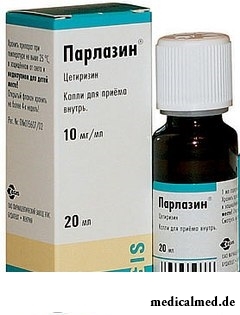





Parlazin
Application instruction:
 Parlazin – the drug having antiallergic effect.
Parlazin – the drug having antiallergic effect.
Form of release and structure
Dosage forms of release of Parlazin:
- Drops for intake: almost colourless or colourless, without deposit, have a slight characteristic smell of acetic acid (on 20 ml in dark glass bottles droppers, on 1 bottle dropper in a cardboard pack);
- Tablets, film coated: biconvex, with a facet, light orange, oblong, inodorous; on one party – risk, on another – an engraving "Е 511"; on a break: a periblast – light orange, a kernel – white or almost white (on 5 or 7 pieces in blisters, on 1 blister in a cardboard pack; on 10 pieces in blisters, on 1 or 3 blisters in a cardboard pack).
Structure of 10 ml of peroral drops:
- Active agent: цетиризин (in the form of dihydrochloride) – 100 mg;
- Auxiliary components: пропилпарагидроксибензоат – 1,5 mg, propylene glycol – 3500 mg, acetic ice acid – 5 mg, глицерол – 2500 mg, sodium saccharinate – 100 mg, methylparahydroxybenzoate – 13,5 mg, sodium acetate trihydrate – 100 mg, the purified water – to 10 ml.
Structure of 1 tablet:
- Active agent: цетиризин (in the form of dihydrochloride) – 10 mg;
- Auxiliary components and cover: anhydrous colloid silicon dioxide – 0,8 mg, magnesium stearate – 1,7 mg, monohydrate of lactose – 11,5 mg, microcrystallic cellulose – 91 mg, Opadry Y-1-7000 (a macrogoal 400, a gipromelloza, titanium dioxide (C.I.77891)) – 4 mg, yellow dye a sunset (yellow sanst ariavit (C.I.15985)) – 0,01 mg.
Indications to use
- Quincke's disease;
- Seasonal and year-round allergic rhinitis and conjunctivitis;
- Pruritic allergic dermatosis;
- Seasonal allergic rinokonjyunktivit;
- Small tortoiseshell (including chronic idiopathic).
Contraindications
Absolute:
- Renal failure (clearance of creatinine <10 ml a minute);
- Syndrome of disturbance of absorption of a galactose glucose and lactose intolerance (for tablets);
- Age till 1 year (for peroral drops) or 6 years (for tablets);
- Period of pregnancy and lactation;
- Hypersensitivity to drug components.
Relative (Parlazin appoint with care after dose adjustment in the presence of the following states / diseases):
- Renal failure in a chronic current of average and heavy degree;
- Advanced age.
Route of administration and dosage
Tablets and drops Parlazin accept inside. Before reception of a drop it is necessary to mix with a small volume of water.
The recommended scheme of use of drug (10 mg of active ingredient contain in 1 tablet or 20 drops):
- Children 1-2 years (drop): 5 mg in 2 receptions;
- Children of 2-6 years (drop): 5 mg in 1 or 2 receptions;
- Children of 6-12 years (tablet or drop): 10 mg in 1 or 2 receptions;
- Adults and children of 12 years (a tablet or a drop): 10 mg in 1 reception.
Drug should be accepted daily. At frequency rate of reception once a day – drug is more preferable to accept in the evening, 2 times a day – in equal parts in the morning and in the evening.
Dose adjustment can be required by elderly patients.
At functional disturbances of kidneys the dose is defined by clearance of creatinine:
- ≥50 ml/min. (normal function of kidneys and easy disturbances): 10 mg in 1 reception;
- 30-49 ml/min. (moderate disturbances): 5 mg in 1 reception;
- 11-29 ml/min. (heavy disturbances): 5 mg in 1 reception every other day;
- ≤10 ml/min. (hemodialysis): Parlazin do not appoint.
Formula for definition of value of the clearance of creatinine (CC):
KK = body weight (in kg)/72 × [140 - age (advanced in years)] - blood serum creatinine (in mg/dl).
For women the received KK value is multiplied on 0,85.
Side effects
Parlazin in most cases is had by patients without development of side effects. Development of such disturbances as is in certain cases possible:
- Allergic reactions: hypersensitivity up to development of an acute anaphylaxis;
- Hemopoietic system: thrombocytopenia;
- Respiratory system: inflammation of a mucous membrane of a throat (pharyngitis) and nasal cavities (rhinitis);
- Alimentary system: nausea, diarrhea, dryness of a mucous membrane of an oral cavity, pain in a stomach, an abnormal liver function (increase in activity of hepatic transaminases, an alkaline phosphatase, gamma глутамилтрансферазы, concentration of bilirubin);
- Nervous system: hallucinations, tic, dizziness, drowsiness, headache, excitement, tremor, aggression, confusion of consciousness, depression, faint, sleeplessness, spasms, dyskinesia of biliary tract, dystonia, paresthesias;
- Cardiovascular system: tachycardia;
- Urinary system: dysuria, urine incontience;
- Sight: disturbance of accommodation and visual perception, involuntary oscillating motions of eyes (nystagmus);
- Hypodermic cellulose and skin: itch, rash, urticaria, Quincke's disease;
- Others: adynamy, indisposition, fatigue, hypostases, increase in weight.
Special instructions
At development of reactions of hypersensitivity Parlazin cancel.
At patients with functional disturbances of kidneys active ingredient can collect in an organism. It even in cases of administration of drug in therapeutic doses can lead to increase in weight and frequency of collateral anticholinergic disturbances or impact on the central nervous system. For this group of patients administration of drug in the lowered doses is recommended.
Parlazin's reception needs to be interrupted not later, than in 3 days before performance of a skin allergy test (because of probability of obtaining false-negative results).
To anticholinergic action of Parlazin (in the form of an ischuria, dryness in a mouth) special sensitivity is shown by elderly patients. If these disturbances are observed the long period, and also in cases of increase in their intensity, treatment needs to be interrupted.
During Parlazin's reception by the patient it is recommended to be careful at control of vehicles, and also performance of other potentially dangerous works at which bystry psychomotor reactions and high concentration of attention are required.
Medicinal interaction
Interaction with Cimetidinum, ketokonazoly, diazepam, erythromycin, azithromycin and pseudoephedrine was not revealed.
During treatment it is impossible to take alcohol.
At the combined use of a tsetirizin from 400 mg of theophylline a day reduction of the general clearance of Parlazin is observed (without changes of kinetics of theophylline).
Simultaneous use with antibiotic drugs from group of macroleads and ketokonazoly does not cause clinically significant changes on the electrocardiogram.
Terms and storage conditions
To store in protected from light, the place, unavailable to children, at a temperature up to 25 °C.
Period of validity – 4 years.
It is possible to store drops after opening of a bottle dropper not longer than 30 days.
Name of drug
Price
Drugstore
The most rare disease – a disease the Kura. Only representatives of the tribe Faure in New Guinea are ill it. The patient dies of laughter. It is considered that eating of a human brain is an origin of a disease.

Physical activity is necessary for normal functioning of a human body. At a lack of the movement cease функц...
Section: Articles about health
The person, as well as all other beings living on our planet feels weather changing. It is the normal meteosensitivity which is not causing to healthy people of special troubles. Meteodependence, on the contrary, is morbid condition, характеризующимс...
Section: Articles about health
Use of medicinal plants in therapy is urgent today, more than ever. The drugs made of curative herbs cannot replace completely modern synthetic drugs, but their use becomes frequent serious help in simplification of a course of many illnesses and improvement of quality of life of chronic patients....
Section: Articles about health
Water with a lemon - idle time in preparation drink which supporters of a healthy lifestyle already managed to appreciate. Upo...
Section: Articles about health
The winter swimming in open reservoirs called in our country by "winter swimming" – officially recognized sport and one of the most extreme ways of a hardening of an organism. This occupation has an old story and adherents in many countries. Are annually carried out...
Section: Articles about health
Within several decades of our compatriots convinced that the use of butter nasty affects a condition of coronary vessels. As a result the reputation of a product was impaired thoroughly a little, and many almost ceased to include it in the diet, having given preference "to safer" to vegetable fats. Meanwhile, the last researches showed that harm of butter for health is strongly exaggerated. But the product has a number of unique properties, to...
Section: Articles about health
The main role in development of a peptic ulcer of a stomach and duodenum the bacterium Helikobakter plays pilor. Activity and Wuxi...
Section: Articles about health
The concept "gluten" (differently, a gluten) combines group of the proteins which are a part of rye, barley and wheat. For most of people the use of the food stuffs containing a gluten not only is safe, but also it is very useful. Nevertheless, there is a number the myth...
Section: Articles about health
The name of this disease precisely reflects the problem reason: it consists in the bra fastener pressure upon a certain zone of a back. At the same time one of vertebrae of chest department of a backbone is as if blocked and loses mobility, and the loading falling on it is distributed on the next vertebrae. At 70-80% of women local pains in a backbone point on which the fastener of the often put most on bra presses result....
Section: Articles about health
For most of the working people the problem of having a snack is particularly acute enough. Sooner or later there is a question: what is possible quickly for a sja...
Section: Articles about health
Cystitis, or inflammation of a mucous membrane of a bladder, this very widespread disease which, owing to some features of a structure of bodies of urinogenital system, women have approximately four times more often than men. In the main risk group...
Section: Articles about health
With age in a human body harmful substances collect. We receive them with food and water, at inhalation of the contaminated air, reception of medicines, use of household chemicals and cosmetics. A considerable part of toxins accumulates in a liver which main function is continuous purification of blood. This body begins to knock as any got littered filter, and efficiency of its work decreases....
Section: Articles about health
The mankind knows that some toxins at intake in the minimum quantities have therapeutic effect...
Section: Articles about health
Tick-borne encephalitis – one of the most dangerous viral diseases which causative agents transfer and is given to people by ixodic mites. These are the small blood-sicking insects living in the considerable territory of our country. The person bitten by a tick can catch...
Section: Articles about health
Stability of a hormonal background is one of the most important conditions of preservation of health of the woman. At the same time endocrine system – the thin device extremely sensitive to any external influences. Changes of a way of life (for example, a diet), emotional stresses, infectious diseases, reception of some drugs can become the reason of hormonal failure. Besides, work of hemadens has the natural specifics in certain moments of life: on various St...
Section: Articles about health
Ability of an organism to resist to adverse environmental factors (to impact of temperature drops, humidity and pressure...
Section: Articles about health
The technique of acupuncture (acupuncture) is used in the medical purposes more than three and a half millennia. It is eurysynusic and recognized as official medicine in the majority of the developed countries of the world. Influence by fine needles on so-called points...
Section: Articles about health
Bathing in broths of medical flowers and plants (phytobathtub) was eurysynusic since Cleopatra who is a good judge in all that concerns beauty and health. And today phytobathtubs is the simple and available means allowing not only to remove nervous tension, but also to recover from many diseases. Grass bathtubs at treatment of cold, osteochondrosis, radiculitis, skin diseases, and also diseases of urinary tract and vessels are especially effective....
Section: Articles about health
Life of the modern woman is very difficult. Opportunities to realize itself are wide: it not only education and career, but also most differently...
Section: Articles about health
Summer in the heat. Many are going to spend vacation abroad. Travelers the tender seas, rest on beaches wait, for sightseeing, campaigns on natural and cultural reserves. But, unfortunately, on vacation also problems about health can wait for us...
Section: Articles about health
All the known slogan "Protect Men!" arose not from scratch. In a sense, the nature created men much less adapted for vital disorders, than it seems at first sight. Statistically, men are ill more often, than women, have the majority of illnesses heavier and earlier die. The situation is aggravated with the fact that our fathers, husbands, brothers and sons are not always inclined to care for the health. Partly it happens because of unwillingness of t...
Section: Articles about health
Obesity is called by a disease of 21 centuries, for the last 100 years by the number of the people suffering from excess body weight, considerably increased...
Section: Articles about health
Color of plants is caused by presence at them of certain chemical compounds. Let's talk about what is meant by various colors of vegetables and fruit and what properties they give them....
Section: Articles about health
History of mankind contains several tens of epidemics whose emergence was compared by eyewitnesses and historians to doomsday. The most terrible of them claimed the lives of millions of people, having made even the whole people to the person of the earth. What they − the diseases striking terror? Whether it managed to the person to find treatment, or he is still powerless before forces of nature?...
Section: Articles about health
The nature does not stand stagnation and monotony. It is known that tissues of a human body atrophy if do not receive necessary loadings...
Section: Articles about health
Life activity of one-celled fungi of the sort Candida, related to yeast is a proximate cause of development of candidiasis (milkwoman). Normal these microorganisms are a part of the microflora living in an oral cavity and intestines of most of people, and that...
Section: Articles about health
The advantage of swimming for the person is so high that this sport is not only the most popular, but also is widely applied in medicine and rehabilitation processes. If you look for for yourself the occupation allowing pleasantly and to spend time, then swimming with advantage – the fact that it is necessary for you. And give learns several facts about swimming....
Section: Slideshow

